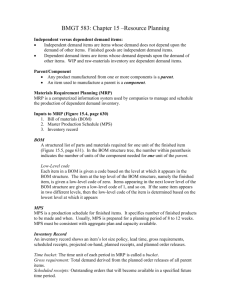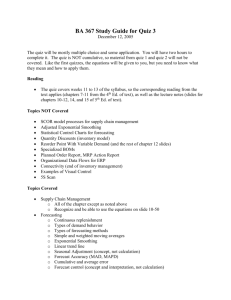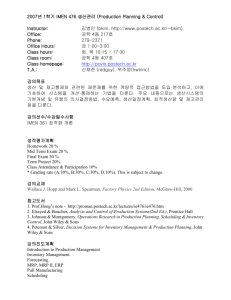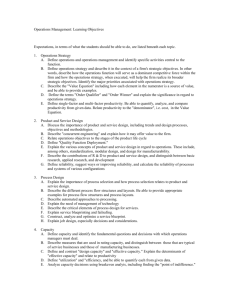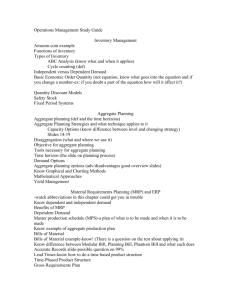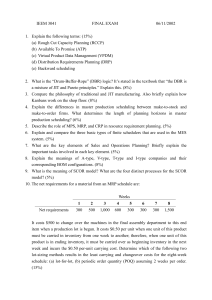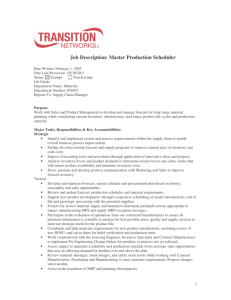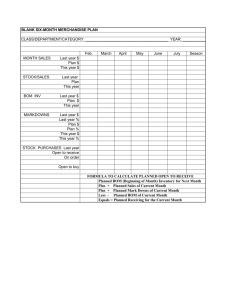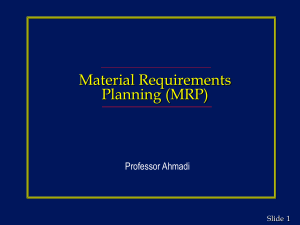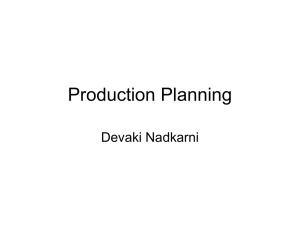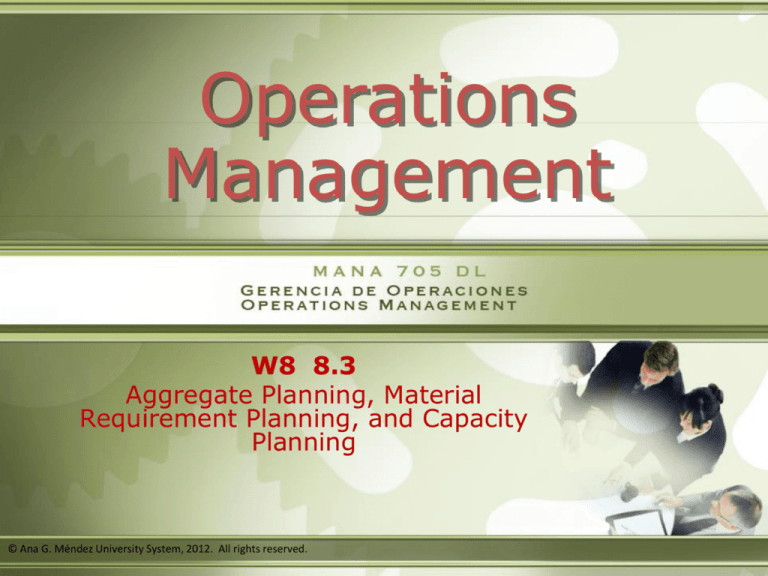
Operations
Management
W8 8.3
Aggregate Planning, Material
Requirement Planning, and Capacity
Planning
© Ana G. Méndez University System, 2012. All rights reserved.
Outline for Workshop Eight
Aggregate Planning Process
What is Aggregate Planning?
Strategies for Aggregate Planning
Material Requirement Planning (MRP)
What is MRP?
Dependent Inventory Model
Requirements
MRP Structure
Lot-Sizing Techniques
MRP II Closed Loop and Capacity
Planning
Breakeven Point
Specific Objectives for Workshop Eight
At the end of the workshop, you will be able to:
1.
2.
3.
4.
5.
6.
7.
Define aggregate planning.
Identify strategies for developing an aggregate plan.
Understand the graphical and mathematical planning of
other aggregate plans.
Describe Material Requirement planning (MRP) and
how to build the product structure, the gross
requirements plan, the net requirements plan and lot
sizes for lot, and EOQ.
Describe Material Resource Planning (MRP II) and the
closed loop.
Define Capacity Planning (CP), Capacity Requirement
Planning (CRP), design capacity, effective capacity,
utilization and efficiency.
Identify and compute break even.
Aggregate Planning
Aggregate planning, also known as aggregate
scheduling, is concerned with determining the
quantity and timing of production for the
intermediate future, often from three to eighteen
months ahead.
Operations managers try to determine the best
way to meet forecasted demand by adjusting
production rates, labor levels, inventory levels,
overtime work, subcontracting rates,
and other controllable variables.
Aggregate Planning Objectives
Minimize Costs/Maximize Profits
Maximize Customer Service
Minimize Inventory Investment
Minimize Changes in Production Rates
(Setup cost)
Minimize Changes in Workforce Levels
Maximize Utilization of Plant and
Equipment
Aggregate Planning Strategies
Should inventories be used to absorb changes
in demand during the planning period?
Should changes be accommodated by varying
the size of the workforce?
Should part-timers be used, or should overtime
and idle time absorb fluctuations?
Should subcontractors be used on fluctuating
orders so a stable workforce can be
maintained?
Should prices or other factors be changed to
influence demand?
Aggregate Planning Strategies
Option
Capacity Option:
Changing inventory
levels
Advantage
Changes in HR are gradual
or none.
Varying workforce size
by hiring or layoffs
Avoids the costs of other
alternatives.
Disadvantage
Comments
Inventory holding costs may
increase. Shortages may
result in lost sales.
Hiring, layoff, and training
costs may be significant.
Applies mainly to production not
service, operations.
Varying production
Matches seasonal
rates through overtime fluctuations without
or idle time
hiring/training costs.
Overtime premiums; tired
workers; may not meet
demand.
Allows flexibility within the
aggregate plan.
Subcontracting
Permits flexibility and
smoothing of the firm's
output
Is less costly and more
flexible than full-time
workers.
Loss of quality control;
reduced profits; loss of future
business.
High turnover/training costs;
quality suffers; scheduling
difficult.
Applies mainly in production
settings.
Tries to use excess capacity.
Discounts draw new
customers
May avoid overtime. Keeps
capacity constant.
Uncertainty in demand. Hard
to match demand to supply
exactly.
Customer must be willing to
wait for an order or goodwill
is lots . Should this be high
or should it be lost?
May require skills or
equipment outside firm's
areas of expertise.
Creates marketing ideas.
Overbooking used in some
businesses.
Many companies back order.
Using part time
workers
Used when changing inventory
and size of labor pool is large.
Good for unskilled jobs in areas
with large temporary labor pools.
Demand Option:
Influencing demand
Back ordering during
high-demand periods
Counter seasonal
product and service
mixing
Fully utilizes resources;
allows stable workforce.
Risky finding products or services
with opposite demand patterns.
Mixed options to develop a plan
Chase strategy
Match output rates to
demand forecast for
each period
Vary workforce levels
or vary production rate
Favored by many
service organizations
Level strategy
Daily production is
uniform
Use inventory or idle
time as buffer
Stable production
leads to better quality
and productivity
Hybrid or Mix
Some combination of capacity options, a
mixed strategy, might be the best
solution
The Planning Process
Production
Capacity
Inventory
Marketing
Customer
demand
Procurement
Supplier
performance
Management
Return on
investment
Capital
Source:
Reizer, J., Render, B. (2007). Operations Management . 9th
Edition. Chapter 14.
Finance
Cash flow
Human resources
Manpower
planning
Aggregate
production
plan
Master production
schedule
Engineering
Design
completion
Change
production
plan?
The Planning Process and Material
Requirement Plan (MRP)
Master production
schedule
Change
requirements?
Change
master
production
schedule?
Material
requirements plan
Change capacity?
Capacity
requirements plan
No
Realistic?
Yes
Execute capacity
plans
Source:
Reizer, J., Render, B. (2007). Operations
Management . 9th Edition. Chapter 14.
Execute
material plans
Is capacity
plan being
met?
Is execution
meeting the
plan?
Master Production Schedule (MPS)
Specifies what is to be made and
when
Must be in accordance with the
aggregate production plan
Inputs from financial plans,
customer demand, engineering,
supplier performance
As the process moves from
planning to execution, each step
must be tested for feasibility
The MPS is the result of the
production planning process
MPS is established in terms of
specific products
Schedule must be followed for a
reasonable length of time
The MPS is quite often fixed or
frozen in the near term part of
the plan
The MPS is a rolling schedule
The MPS is a statement of what
is to be produced, not a forecast
of demand
Different Process Strategies
Make to Order
(Process Focus)
Assemble to Order or
Forecast
(Repetitive)
Number of
end items
Stock to Forecast
(Product Focus)
Schedule finished
product
Schedule modules
Typical focus of the
master production
schedule
Schedule orders
Number of
inputs
Examples:
Print shop
Machine shop
Fine-dining restaurant
Motorcycles
Autos, TVs
Fast-food restaurant
Steel, Beer, Bread
Lightbulbs
Paper
From the MPS to MRP Process
Customer Orders
Bills of Material
Purchase Orders
Master Production
Schedule
Material
Requirement
Planning
Work Orders
Forecast Demand
Inventory
Material Requirement Planning (MRP)
MRP is the system that has been put in place to enable a
business to manage its inventory levels. Inventory in a
manufacturing business is made of the materials that go
into the manufacturing process.
The benefits of MRP:
Better response to customer orders
Faster response to market changes
Improved utilization of facilities and labor
Reduced inventory levels
MRP and the Dependent Demand
Effective use of dependent
demand inventory models
requires the following:
1. Master production schedule
2. Specifications or bill of material
3. Inventory availability
4. Outstanding purchase orders
5. Lead times
Bills of Material (BOM)
There are approximately 8 types of bills of
material. Here are some of the most used
ones.
This shows the Parent and is
typically called Product Tree,
and also a Multi Level Bill
Both BOM Source:
DRM Associates, PD-Trak Solutions (2010). Retrieved from: http://www.npd-solutions.com/bom.html.
This is a
Summarized
BOM
Bills of Material (BOM)
This is a Single-Level
BOM
Both BOM Source:
DRM Associates, PD-Trak Solutions (2010). Retrieved from: http://www.npd-solutions.com/bom.html.
This is an Indented BOM
MRP Needs Accurate
Records
Accurate inventory records are
absolutely required for MRP (or any
dependent demand system) to
operate correctly
Generally MRP systems require 99%
accuracy
Outstanding purchase orders must
accurately reflect quantities and
scheduled receipts
Lead Times
The time required to purchase, produce,
or assemble an item
For production – the sum of the
order, wait, move, setup, store, and
run times
For purchased items – the time
between the recognition of a need
and the availability of the item for
production
The Process to Determine
Gross Requirements
Starts with a production
schedule for the end item
Using the lead time for the
item, is determined the
week in which the order
should be released
This step is often called
“lead time offset” or “time
phasing”
From the BOM, every Item A
requires X amounts of Item
B
The lead time for Item B is X
weeks
The timing and quantity for
component requirements are
determined by the order
release of the parent(s)
The process continues through
the entire BOM one level at a
time – often called “explosion”
By processing the BOM by
level, items with multiple
parents are only processed
once, saving time and
resources and reducing
confusion
Low-level coding ensures that
each item appears at only one
level in the BOM
Net Requirements Plan
Source:
Reizer, J., Render, B. (2007). Operations Management . 9th Edition. Chapter 14.
The Logic of Net Requirements
Gross
requirements
+
Allocations
Total requirements
–
On
hand
+
Scheduled
receipts
= Net requirements
Available inventory
Source:
Reizer, J., Render, B. (2007). Operations Management . 9th Edition. Chapter 14.
Safety Stock also called “Buffer”
BOMs, inventory records,
purchase and production
quantities may not be
perfect
Consideration of safety
stock may be prudent
Should be minimized and
ultimately eliminated
Typically built into
projected on-hand
inventory
Source:
Resource Systems Group (2012). Lean Six Sigma Chain. Retrieve from:
http://www.resourcesystemsconsulting.com/blog/wpcontent/uploads/SS.png.
Lot Sizing Techniques
Lot-for-lot techniques order just what is required for
production based on net requirements
May not always be feasible
If setup costs are high, lot-for-lot can be expensive
Economic order quantity (EOQ)
EOQ expects a known constant demand and MRP
systems often deal with unknown and variable
demand
Part Period Balancing (PPB) looks at future orders to
determine most economical lot size
The Wagner-Whitin algorithm is a complex dynamic
programming technique
Assumes a finite time horizon
Effective, but computationally burdensome
Utilization and Efficiency
Utilization is the percent of design capacity achieved
Utilization = Actual output/Design capacity
Efficiency is the percent of effective capacity achieved
Efficiency = Actual output/Effective capacity
Capacity and Strategy
Capacity decisions impact all 10 decisions of
operations management as well as other
functional areas of the organization
Capacity decisions must be integrated into
the organization’s mission and strategy
Capacity
Considerations
Forecast demand accurately
Understand the technology and
capacity increments
Find the optimum
operating level
(volume)
Build for change
Break-Even Analysis
Technique for evaluating
process and equipment
alternatives
Objective is to find the
point in dollars and units
at which cost equals
revenue
Requires estimation of
fixed costs, variable costs,
and revenue
Fixed costs are costs that
continue even if no units
are produced
Depreciation, taxes,
debt, mortgage
payments
Variable costs are costs
that vary with the
volume of units produced
Labor, materials,
portion of utilities
Contribution is the
difference between
selling price and
variable cost
Source:
12 Manage The Executive Fast Track (2011). Break Even Point Analysis. Retrieved from:
http://www.12manage.com/methods_break-even_point.html
Break-Even Point
Assumptions
Costs and revenue
are linear functions
Generally not the
case in the real
world
We actually know
these costs
Very difficult to
accomplish
There is no time
value of money
Source:
12 Manage The Executive Fast Track (2011). Break Even Point Analysis. Retrieved from:
http://www.12manage.com/methods_break-even_point.html
Break-Even Point Analysis
BEPx = break-even point in units
BEP$ = break-even point in
dollars
P = price per unit (after all
discounts)
x = number of units produced
TR
F
V
TC
=
=
=
=
total revenue = Px
fixed costs
variable cost per unit
total costs = F + Vx
Break-even point occurs when
TR = TC
or
Px = F + Vx
BEP$ = BEPx P
F
=
P
P-V
F
Profit = TR - TC
=
(P - V)/P
= Px - (F + Vx)
F
=
= Px - F - Vx
1 - V/P
= (P - V)x - F
F
BEPx =
P-V
End of Presentation
You have finished the presentation.
Please continue with the Workshop
Activities.

